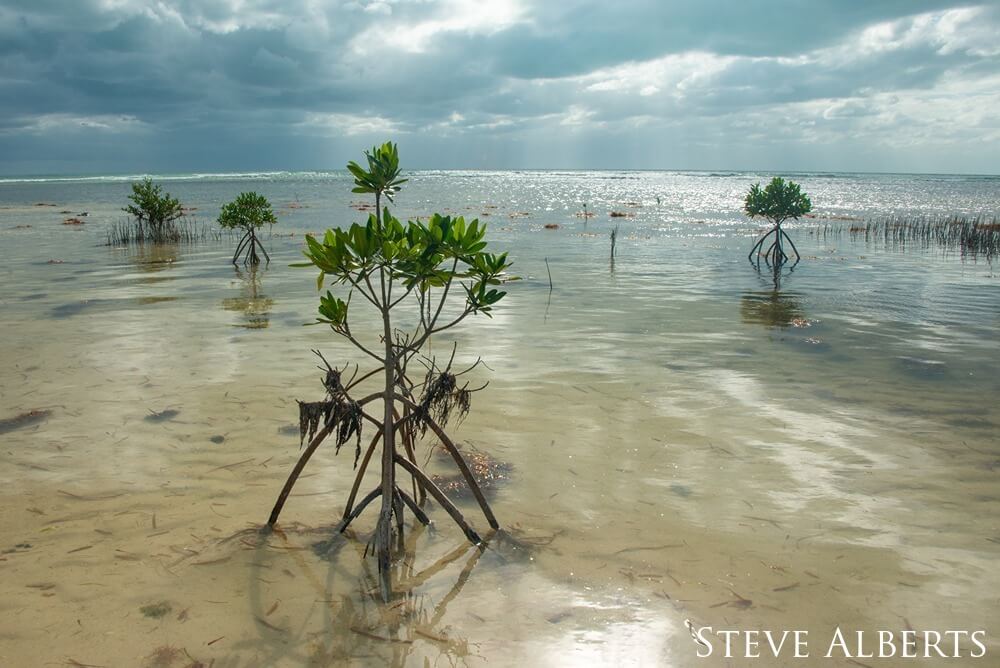Mangrove Forest

The trees you see in the water along the shores of the Florida Keys are mangroves. Mangroves are a salt-tolerant type of tree that line more than 1,800 miles of shoreline within Florida Keys National Marine Sanctuary — that's almost the distance from Key West to Maine!
What are Mangroves?
Mangroves forests are vegetative, intertidal wetlands. There are about 80 different species of mangrove across the world. These specially adapted trees and shrubs grow in areas with low-oxygen soil, where slow-moving waters allow fine sediments to accumulate. Mangrove forests only grow at tropical and subtropical latitudes near the equator because they cannot withstand freezing temperatures.
There are three species of mangrove that are common in the Florida Keys:

(Rhizophora mangle)

(Avicennia germinans)

(Laguncularia racemosa)

The red mangroves can withstand the harshest of conditions, often growing along the edges of the shoreline. They have recognizable long, reddish "prop roots" that extend from the trunk, resembling tall stilts. These roots increase stability and supply oxygen to underground roots that are growing in often low-oxygen soil conditions.
A unique adaptation of the red mangrove is that their seeds (propagules) can germinate while still attached to the parent tree. When the propagules finally drop, they are actually fully mature plants that get dispersed by the water until they find suitable ground to take root in.
Importance of Mangroves
Coral reefs, hard-bottom habitats, seagrass meadows, and mangrove forests are all ecologically connected. Many commercially and recreationally important reef fish and invertebrates use mangroves as a nursery habitat, finding refuge in their tangled roots.

Mangroves are shoreline protectors. The thick roots allow them to withstand strong winds, protecting coastlines from storm damage. They help attenuate wave action. Mangroves also trap sediments and contaminants from land that could bury and suffocate nearby hard-bottom and coral reef habitats.
Mangroves are builders. Their roots collect sediments that create more land and build up islands. This strong shoreline connects the land and the sea and provides homes for animals.

Mangroves are homes. The tidally exposed parts of their prop roots provide excellent structure for encrusting algae and invertebrates such as sponges, tunicates, and barnacles to grow. With plenty of hiding space, small fish and other creatures find shelter in the dense tangle of mangrove roots, while seabirds build their nests among the branches.
Mangroves store blue carbon. Blue carbon ecosystems such as mangrove forests can help address climate change because they remove carbon dioxide from the atmosphere and store it for long timescales in roots, branches, and sediments.

Mangroves help cycle nutrients. Mangroves take up nutrients in order to grow, and are a major long-term sink for nitrogen. As leaves and branches fall from the trees in the form of litter, it is then decomposed by primary consumers. Bacteria and protozoans colonize the plant litter and break it down chemically into organic compounds, minerals, carbon dioxide, and nitrogenous wastes.
Threats to Mangrove Habitats
Mangroves may seem incredibly resilient, but habitat destruction and poor water quality pose threats to these important protectors. In the Florida Keys, human development is the greatest threat to mangrove communities. Since the 1950s, more than 60% of mangroves in Monroe County have been destroyed for development. If mangroves were to disappear from the Florida Keys, there would not be another salt-tolerant tree species capable of filling their important role in the ecosystem.
Given the importance of mangroves and their continued destruction, the Mangrove Trimming and Preservation Act was passed in 1996, making it illegal to remove, destroy, or damage mangroves in the state of Florida. The law also calls upon the use of certified, professional mangrove trimmers to ensure that these trees are properly maintained. Mangroves have also been designated a species of special concern.
You can help mangroves by letting others know how important they are, and that it is illegal to harm or remove them in Florida. You can also help by taking steps to reduce pollutant runoff from land, such as by not using pesticides and fertilizers prior to a rain shower.

